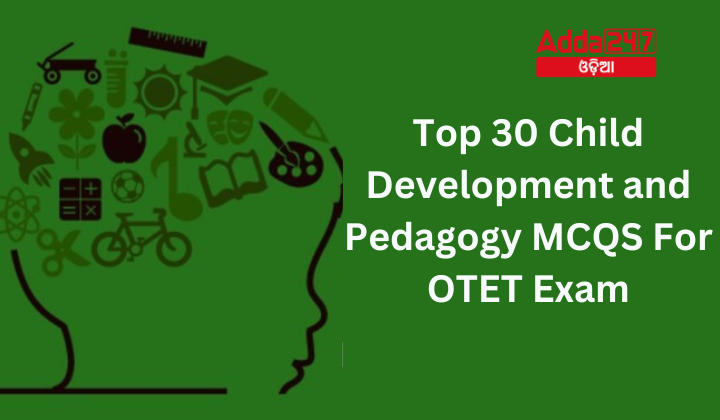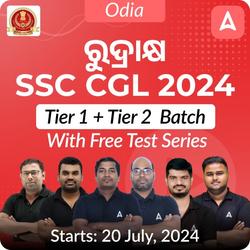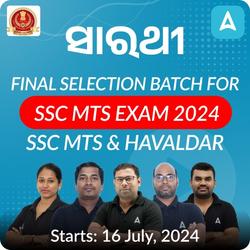The Odisha Teacher Eligibility Test (OTET) assesses the eligibility of candidates to teach in schools of Odisha. A crucial section of this exam is Child Development and Pedagogy, which evaluates understanding of child development and the principles of pedagogy. Below are 30 multiple-choice questions (MCQs) designed to help candidates prepare for this section.
Top 30 Child Development and Pedagogy MCQS For OTET Exam
Which of the following is NOT considered a primary or physiological need?
(a) Need for water
(b) Need for rest and sleep
(c) Need for social approval
(d) Need for food
Ans. (c) Need for social approval
Adolescents have a strong desire to:
(a) Be independent
(b) Love and be loved
(c) Gain social approval
(d) All of the above
Ans. (d) All of the above
What can be a consequence for an adolescent who lacks the feeling of security?
(a) Enhanced creativity
(b) Maladjustment
(c) Increased social skills
(d) Improved academic performance
Ans. (b) Maladjustment
Which need is closely associated with man’s desire for gregariousness?
(a) Need for love
(b) Need for security
(c) Need for freedom
(d) Need for self-expression
Ans. (b) Need for security
Which of the following best describes the problems related to the intensification of sex-consciousness during adolescence in the Indian context?
(a) Lack of interest in sexual matters
(b) Seeking scientific and accurate knowledge
(c) Resorting to socially unacceptable ways for information
(d) Open discussion about sex in families
Ans. (c) Resorting to socially unacceptable ways for information
Adolescents often face adjustment difficulties with parents due to:
(a) Lack of freedom and independence
(b) Unclear communication from parents
(c) Strict school discipline
(d) All of the above
Ans. (a) Lack of freedom and independence
The conflict between being treated as a child and wanting to be treated as an adult is referred to as:
(a) Somatic variation conflict
(b) Childhood-Adulthood conflict
(c) Peer pressure conflict
(d) Ideal and reality conflict
Ans. (b) Childhood-Adulthood conflict
What role can parents play in helping adolescents manage the Ideal and Reality conflicts?
(a) Setting clear and fair rules
(b) Avoiding discussions about peer influences
(c) Limiting affection and concern
(d) Encouraging unquestioning obedience
Ans. (a) Setting clear and fair rules
The desire for self-expression and achievement in adolescents implies:
(a) A need for physiological satisfaction
(b) A need to fulfill their potentialities
(c) A need for social isolation
(d) A need to conform to parental expectations
Ans. (b) A need to fulfill their potentialities
What is a common issue faced by adolescents in adjusting to school discipline?
(a) Excessive freedom in school
(b) Submission to tyrannical teachers
(c) Lack of academic challenges
(d) Too much peer influence
Ans. (b) Submission to tyrannical teachers
Who proposed the theory of classical conditioning?
(a) B.F. Skinner
(b) Albert Bandura
(c) Ivan P. Pavlov
(d) John B. Watson
Ans. (c) Ivan P. Pavlov
In Pavlov’s experiment, what was the unconditioned stimulus (UCS)?
(a) The bell
(b) The harness
(c) The dog
(d) The meat
Ans. (d) The meat
In Pavlov’s experiment, what was the conditioned stimulus (CS)?
(a) The meat
(b) The bell
(c) The harness
(d) The dog
Ans. (b) The bell
In classical conditioning, what is the response that is naturally elicited by the unconditioned stimulus?
(a) Conditioned response
(b) Unconditioned response
(c) Neutral response
(d) Spontaneous recovery
Ans. (b) Unconditioned response
What term describes the process when a conditioned response decreases after repeated exposure to the conditioned stimulus without the unconditioned stimulus?
(a) Generalisation
(b) Discrimination
(c) Extinction
(d) Spontaneous recovery
Ans. (c) Extinction
What is the term for the reappearance of an extinguished conditioned response after a rest period?
(a) Generalisation
(b) Discrimination
(c) Extinction
(d) Spontaneous recovery
Ans. (d) Spontaneous recovery
When a dog salivates at the sound of a bell, this is an example of:
(a) Operant conditioning
(b) Classical conditioning
(c) Instrumental conditioning
(d) Reinforcement
Ans. (b) Classical conditioning
If a dog salivates to a bell and also to a similar-sounding bell, this is an example of:
(a) Generalisation
(b) Discrimination
(c) Extinction
(d) Spontaneous recovery
Ans. (a) Generalisation
In the context of classical conditioning, what is discrimination?
(a) Responding to all similar stimuli in the same way
(b) Responding only to the conditioned stimulus and not to similar stimuli
(c) The disappearance of a learned response
(d) The reappearance of a learned response
Ans. (b) Responding only to the conditioned stimulus and not to similar stimuli
What process involves the pairing of a neutral stimulus with an unconditioned stimulus to elicit a conditioned response?
(a) Operant conditioning
(b) Classical conditioning
(c) Observational learning
(d) Cognitive conditioning
Ans. (b) Classical conditioning
What is the main aim of Continuous and Comprehensive Evaluation (CCE)?
(a) To reduce the workload of teachers
(b) To assess every aspect of the child during their presence at the school
(c) To eliminate the need for exams
(d) To standardize education across the country
Ans: (b) To assess every aspect of the child during their presence at the school
Which term in CCE emphasizes the assessment of all-round development of a student’s personality?
(a) Continuous
(b) Comprehensive
(c) Scholastic
(d) Formative
Ans: (b) Comprehensive
Formative assessment typically involves which of the following?
(a) End-of-term exams
(b) Diagnostic testing
(c) Final grades
(d) Standardized tests
Ans: (b) Diagnostic testing
Which feature is associated with summative assessment?
(a) Provides real-time feedback during the learning process
(b) Conducted at the end of a unit or semester
(c) Helps in detecting and correcting learning processes
(d) Involves qualitative feedback for students
Ans: (b) Conducted at the end of a unit or semester
What does the term ‘continuous’ signify in CCE?
(a) Frequent assessments
(b) One-time evaluation
(c) Only final exams
(d) Assessing after each academic session
Ans: (a) Frequent assessments
What is the focus of co-scholastic assessment in CCE?
(a) Curricular areas or subject-specific areas
(b) Only academic performance
(c) Life Skills, Co-Curricular Activities, Attitudes, and Values
(d) Standardized testing
Ans: (c) Life Skills, Co-Curricular Activities, Attitudes, and Values
Which of the following is a characteristic of school-based CCE?
(a) It focuses only on academic achievements
(b) It is less transparent than traditional systems
(c) It provides more scope for interaction among learners, teachers, and parents
(d) It eliminates the need for teaching aids
Ans: (c) It provides more scope for interaction among learners, teachers, and parents
Which tool is used for qualitative research in document analysis within CCE?
(a) Portfolio
(b) Anecdotal Records
(c) Observation
(d) Document analysis
Ans: (d) Document analysis
What is the purpose of using checklists in CCE?
(a) To provide numerical grades
(b) To record yes/no responses concerning student illustration of particular criteria
(c) To conduct final exams
(d) To measure teacher performance
Ans: (b) To record yes/no responses concerning student illustration of particular criteria
How does CCE help in minimizing stress on children?
(a) By eliminating homework
(b) By focusing only on final exams
(c) Through continuous and comprehensive assessment
(d) By reducing the number of subjects
Ans: (c) Through continuous and comprehensive assessment





